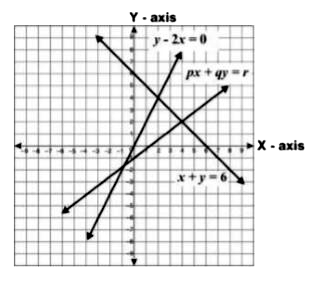If pt ≠ qs, then the pair of equations px + qy = r, sx + ty = u
has a unique solution
has no solution
has infinitely many solutions
Can't be determined
The correct Answer is:A
Step by step video, text & image solution for If pt ne qs, then the pair of equations px + qy = r, sx + ty = u by Maths experts to help you in doubts & scoring excellent marks in Class 10 exams.
Updated on:21/07/2023Topper's Solved these Questions
- IMO QUESTION PAPER 2020 SET 1BOOK - SCIENCE OLYMPIAD FOUNDATION CHAPTER - IMO QUESTION PAPER 2020 SET 1EXERCISE - Everyday Mathematics
10 Videos
- IMO QUESTION PAPER 2020 SET 1BOOK - SCIENCE OLYMPIAD FOUNDATION CHAPTER - IMO QUESTION PAPER 2020 SET 1EXERCISE - Achievers Section
5 Videos
- IMO QUESTION PAPER 2019 SET BBOOK - SCIENCE OLYMPIAD FOUNDATION CHAPTER - IMO QUESTION PAPER 2019 SET BEXERCISE - ACHIEVERS SECTION
5 Videos
- IMO QUESTION PAPER 2020 SET 2 BOOK - SCIENCE OLYMPIAD FOUNDATION CHAPTER - IMO QUESTION PAPER 2020 SET 2 EXERCISE - Achievers Section
4 Videos
Similar Questions
Knowledge Check
Shown below are the graphs of the lines y−2x=0,x+y=6andpx+qy=r

Which of these is the solution for the pair of equations x+y=6 and px+qy=rAx=2,y=4Bx=4, y=2Cx=3, y=2DWe cannot say for sure as the values of p and q are not known.Obtain the condition for the following system of linear equations to has a unique solution
px+qy=r and lx+my=n.Apm = qlBpm - ql = 0Cpm ≠ qlDnone of theseIf the roots of the quadratic equation px2+qx+r=0 are reciprocal to each other ,then the relation between p and r is
Ar≠pBr=pCr=qDNone of these
Find the values of p in (i) to (iv) and p and q in (v) for the following pair of equations
(i) 3x−y−5=0 and 6x−2y−p=0, if the lines represented by these equations are parallel.
(ii) −x+py=1 and px−y=1, if the pair of equations has no solution.
(iii) −3x+5y=7 and 2px−3y=1,
if the lines represented by these equations are intersecting at a unique point.
(iv) 2x+3y−5=0 and px−6y−8=0,
if the pair of equations has a unique solution.
(v) 2x+3y=7 and 2px+py=28−qy,
if the pair of equations has infinitely many solutions.
View SolutionSolve the following pair of linear equations :
px+qy=p−q
qx−py=p+q
View SolutionFind the value(s) of p for the following pair of equations:
2x+3y−5=0andpx−6y−8=0, if the pair of equations has a unique solution.
View SolutionFind p and q, if the equation px2−6xy+y2+18x−qy+8=0 represents a pair of parallel lines.
View SolutionIf pandq(≠0) are the roots of the equation x2+px+q=0, then the value of p must be equal to
View Solution
